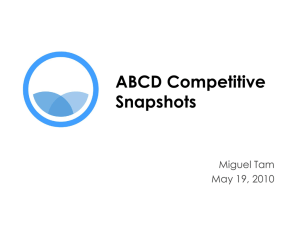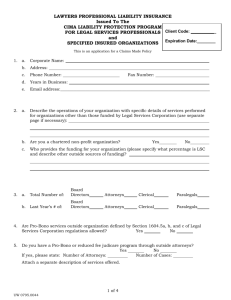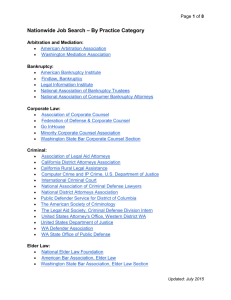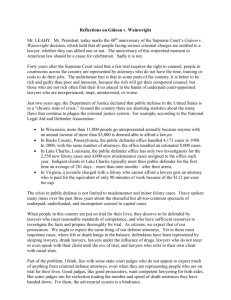Cloudy forecasts
advertisement
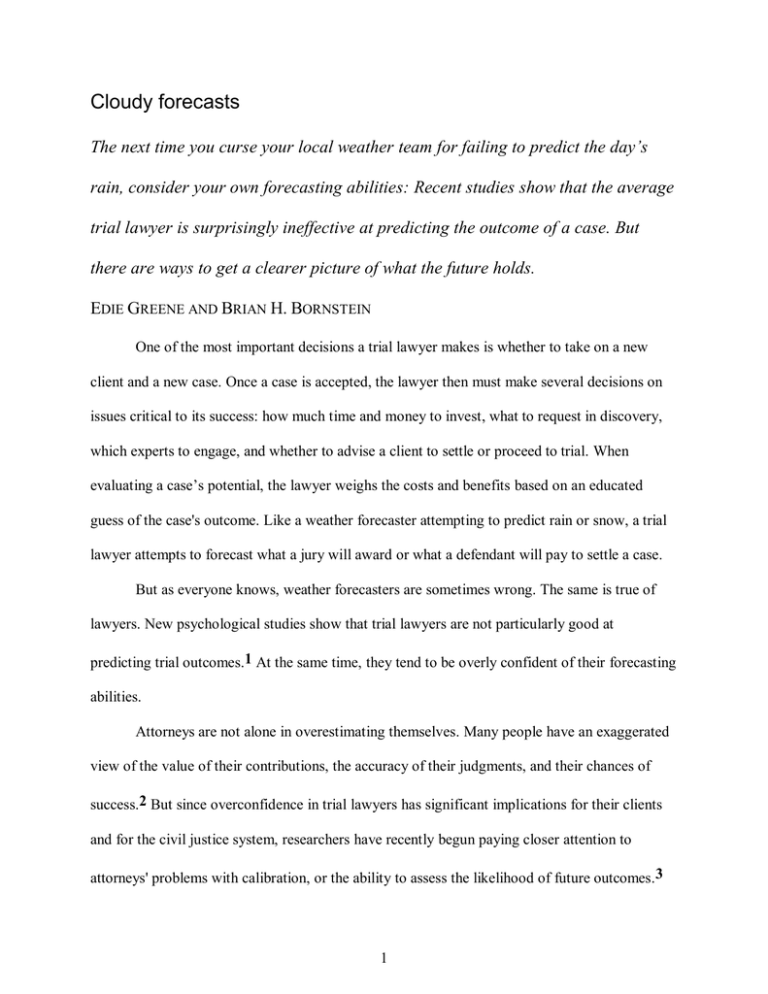
Cloudy forecasts The next time you curse your local weather team for failing to predict the day’s rain, consider your own forecasting abilities: Recent studies show that the average trial lawyer is surprisingly ineffective at predicting the outcome of a case. But there are ways to get a clearer picture of what the future holds. EDIE GREENE AND BRIAN H. BORNSTEIN One of the most important decisions a trial lawyer makes is whether to take on a new client and a new case. Once a case is accepted, the lawyer then must make several decisions on issues critical to its success: how much time and money to invest, what to request in discovery, which experts to engage, and whether to advise a client to settle or proceed to trial. When evaluating a case’s potential, the lawyer weighs the costs and benefits based on an educated guess of the case's outcome. Like a weather forecaster attempting to predict rain or snow, a trial lawyer attempts to forecast what a jury will award or what a defendant will pay to settle a case. But as everyone knows, weather forecasters are sometimes wrong. The same is true of lawyers. New psychological studies show that trial lawyers are not particularly good at predicting trial outcomes.1 At the same time, they tend to be overly confident of their forecasting abilities. Attorneys are not alone in overestimating themselves. Many people have an exaggerated view of the value of their contributions, the accuracy of their judgments, and their chances of success.2 But since overconfidence in trial lawyers has significant implications for their clients and for the civil justice system, researchers have recently begun paying closer attention to attorneys' problems with calibration, or the ability to assess the likelihood of future outcomes.3 1 One study sampled 481 attorneys across the United States. They were asked to estimate the chances of achieving a minimum win (as they defined it) in a case set for trial. A sample question was, “From 0 percent to 100 percent, what is the probability that you will achieve this outcome or something better?"4 The researchers later conducted follow-up phone interviews to find out how each case turned out and found that the attorneys who had predicted a high chance of winning had been overconfident about their cases. In the subset of attorneys who said the probability of winning was greater than 65 percent, the mean estimate was 82 percent--but only 62 percent of these attorneys actually achieved a win. By contrast, in the subset of lawyers who said the chances of a win were less than 45 percent, the mean probability estimate was 27 percent--yet 48 percent of them won. This group underpredicted their chances of success. Not surprisingly, when researchers compared the predicted result with the actual result, they found that the higher the level of certainty a lawyer expressed, the greater his or her calibration error. There are several reasons for this. One is that attorneys judging the likelihood of potential trial outcomes tend to fixate on the one they deem most likely and ignore the others. In a clever demonstration of this phenomenon, researchers assigned attorneys to groups and instructed each group to judge the probability of a particular jury verdict in a hypothetical automobile negligence case. 5 But the choices they offered each group varied: One group judged the probability of an award of up to $25,000; another group judged the probability of a $25,000-$50,000 award; a third group, an award of $50,000-$100,000; and the fourth group estimated the probability of an award of over $100,000. 2 Assume the actual award was $45,000. According to probability theory, if all participants determined an award by carefully considering the facts of the case without being influenced by the range offered, then the group offered a range of $25,000-$50,000 would give a very high percentage, other groups would give much lower percentages, and all the percentages would sum to about 100%. In fact, the groups’ percentages added to 170%. The lawyers overestimated the likelihood of a specific outcome because the ranges of awards offered reduced their ability to consider alternatives. One remedy for this calibration error would be to describe the facts of a case to mock jurors, focus group participants, or colleagues, provide a list of conceivable outcomes, and ask them to evaluate the likelihood of each. Requiring that their estimates add to 100% will provide useful feedback to lawyers who might have made different predictions themselves. The Problems Knowing something about the factors that lead to overconfidence can suggest other ways to improve forecasting. The length of time from estimation to outcome, the absence of feedback on previous predictions, a tendency toward overconfidence fueled by necessary self-promotion, a belief in the client's cause, and a sense of control can lead attorneys to overestimate the accuracy of their forecasts. Timing of forecasts. Attorneys often have to make a prediction about a case months or even years before it is expected to come to trial. Because these predictions are often made on the basis of very little information, attorneys tend not to be overconfident of them. People tend to judge events in the distant future as less probable than events in the near future and, as a result, are less confident about predicting the former than the latter.6 3 But while there is good reason to believe that a forecast made just before a trial will be more accurate than one made some time before, it is still just a guess. All the hours of taking depositions, analyzing pretrial rulings, and preparing witnesses can introduce unwarranted confidence in trial lawyers. Well-prepared attorneys on the eve of trial are not necessarily well calibrated. Absence of feedback. Despite the jokes about their inaccuracy, weather forecasters are actually well calibrated. On days when they predict a 30 percent chance of rain, it actually rains about 30 percent of the time. One reason they excel at prediction is that they have immediate and decisive feedback: It rains that day, or it doesn’t They can also compare data from past forecasts. They improve their calibration accuracy by looking at whether their previous forecasts, based on similar data, were correct. Trial attorneys rarely get such feedback. They almost never know what the “road not taken” looks like—what a jury would have awarded their client if they had not settled, whether a particular expert might have swayed the jury, or how the decision to merge individual plaintiffs into a joint action affected the outcomes for each of them. There’s no way for lawyers to know whether their predictions would have been more accurate if they had done something differently. Self-promotion. Trial lawyers may express heightened confidence in their abilities in order to attract and maintain a clientele.7 In time, especially if they achieve some success, they become convinced of their own professional prowess. They start, in short, to believe their own press. The case as cause. After deciding to pursue a case—and making a financial and emotional investment in it—trial lawyers’ dogged pursuit of a just verdict can blind them to the strengths of their adversaries, the predilections of the judge, or their own weaknesses. 8 In the 4 courtroom, while advocating zealously on behalf of their clients, they can become even more convinced of the rightness and wisdom of their positions. Perceived control. Lawyers typically feel that the result of a trial is largely under their control, that it is primarily dependent on their skills, talent, and hard work. When lawyers can take concrete steps to increase the likelihood of a desired outcome, they may overestimate their own abilities and underestimate their opponents’. This illusion of control results in an expectation of success that is higher than what is warranted by objective reality. 9 The Solutions Errors in judgment can be costly for lawyers and their clients, so lawyers need to think about putting the brakes on their runaway confidence. 10 The ability to predict victory or defeat is key to an attorney's case strategy, and feedback on the accuracy of their forecasts is of paramount importance. Feedback can improve prediction calibration, enabling an attorney to know when to be confident and when to be cautious, when to invest time and money in pursuit of a goal and when to withdraw, when to settle and for how much. This feedback can come from several sources, including mock juries or focus groups, colleagues and other legal professionals, and resources that report general trends in litigation and outcomes in comparable cases. Mock juries or focus groups. The most resource-intense method of gaining insight into a case is to present a condensed version of the facts to a mock jury or focus group. If the presentation is a fair representation of the evidence the lawyer intends to bring to trial and if the results are replicated in different groups, then attorneys can be fairly certain about how a real jury will respond and can use this feedback to align their expectations more closely with reality. 5 Colleagues and other legal professionals. Some firms hold regular meetings where litigators can share opinions about the strengths and weaknesses of their cases. This can be a useful exercise, especially for senior partners who may not be in the practice of seeking advice from their colleagues and who may be particularly overconfident of their forecasting abilities. Sole practitioners can talk with colleagues in other firms and with mediators or arbitrators outside the formal sessions with opposing parties. This third-party input can be especially helpful--though sometimes disconcerting--as a settlement conference or trial date nears and the lawyer becomes increasingly wedded to, and convinced of, the accuracy of his or her analysis. The value of seeking ideas from other lawyers (and really considering them) was shown in a recent study that compared attorneys' individual estimates of damages awards in six personal injury cases with the estimates they made after collaborating with other experienced lawyers. 11 When the attorneys had to guess what an award was on their own, without discussion, only 4 percent of them got it right. Sixty-four percent guessed too low, and 32 percent went too high.12 When given the opportunity to view a partner's estimate and to revise their initial predictions, attorneys placed less weight on their partner's predictions than on their own (overconfidence again?). Only 12 percent moved more than halfway between their initial estimates and their partners' estimates, and 83 percent moved less than halfway. Fully 53 percent chose to ignore their partner's predictions completely. The real benefit of collaboration occurred when the participants were instructed to discuss each case and agree on an amount. These amounts were significantly more accurate (that is, more closely aligned with the actual verdicts) than the individual predictions were. 6 These results suggest that trial lawyers can benefit from access to a second opinion, as long as they are willing to give serious consideration to that opinion. Discussing the merits and likely outcome of a case makes an accurate assessment more likely. Similar cases. Forecasting accuracy might also be improved by researching verdicts in similar cases. But a few cautionary notes are in order. First, it may be difficult to find comparable cases and to account for facts and circumstances different from those in the case at hand. Second, if comparable cases are difficult to find, trial lawyers may simply defer to their personal knowledge of litigation trends--and some new data we have collected suggest that attorneys have major misconceptions on this subject. We recently surveyed several dozen trial lawyers attending continuing legal education (CLE) programs13 about their knowledge of trends in injury-related litigation and compared their responses with actual figures published by the Bureau of Justice Statistics. 14 We asked questions such as What percentage of civil cases is disposed of through trial? In what percentage of trials does the plaintiff win? Are plaintiffs more likely to win in bench trials or jury trials? In what types of case do plaintiffs have the highest and lowest win rates? What is the median award for plaintiffs who win damages? What is the median award for plaintiffs who win motor vehicle cases? In what type of case is the median award for plaintiff winners the highest, and in what type is it the lowest? 7 The results were surprising. Even after granting leeway for answers that were "approximately correct" (deeming as correct any responses that were within a 20 percentage point range of the correct answer), we found surprisingly low rates of accuracy. Only 58 percent of respondents were approximately correct that plaintiffs have an overall win rate of 56 percent, and only 58 percent were aware that plaintiffs are more likely to prevail in bench trials than jury trials (this was an either/or question, so performance was barely better than chance). Further, although nearly 80 percent of the respondents knew, after being presented with a list of 12 options, that plaintiffs had the lowest chances of winning in medical malpractice and products liability cases, only 50 percent knew that plaintiffs had the highest win rate in motor vehicle cases. Even when presented with a range of awards 15 and given leeway for answers that were approximately correct, fewer than half of the respondents could provide the median award for plaintiffs who win damages ($28,000), and only about one-third could provide the correct median award in motor vehicle cases ($15,000). When asked in which type of case the median award for plaintiff winners was highest and lowest and provided with a list of 12 options, only 11 percent answered correctly that median awards are highest in asbestos cases, and only 19 percent responded correctly that they are lowest in motor vehicle cases. The upshot of our findings--from an admittedly small sample--is that even trial attorneys are apparently not well informed about patterns and trends in personal injury litigation. Basing estimates of future success on inaccurate beliefs about the past will do little to improve calibration. If trial lawyers do no additional research when thinking about a case or working to resolve it and instead rely on hunches and assumptions, they may be doing a disservice to their 8 clients—and ultimately to their own financial bottom line. When lack of knowledge combines with inclinations toward overconfidence, forecasts will often be wrong. While using any of these resources can help lawyers improve how they judge cases, the first step should be to take a hard, honest look at their own tendencies to inflate their chances of winning. A more modest outlook may be difficult for trial lawyers to adopt, but it may offer the best hope of seeing the future with clear eyes. EDIE GREENE is a professor of psychology and director of the psychology and law concentration at the University of Colorado-Colorado Springs. She can be reached at egreene@uccs.edu. BRIAN H. BORNSTEIN is a professor of psychology and courtesy professor of law at the University of Nebraska-Lincoln. He can be reached at bbornstein2@unl.edu. 1 Craig R. Fox & Richard Birke, Forecasting Trial Outcomes: Lawyers Assign Higher Probability to Possibilities That Are Described in Greater Detail, 26 L. & Hum. Behavior 159 (2002); Jane Goodman-Delahunty et al., Insightful or Wishful: Lawyers’ Ability to Predict Case Outcomes, 16 Psychol., Pub. Policy & L. 133 (2010). 2 Psychologists have identified three forms of overconfidence: overprecision (excessive certainty in the accuracy of one’s predictions), overplacement (overly inflated notions of one’s value and abilities in comparison with others), and overestimation (augmented beliefs about one’s abilities and chances for success). We suspect that all three are implicated in lawyers' forecasting errors: Trial lawyers may seem excessively precise in judging the likelihood of future events because their professional role demands a show of persuasiveness and certainty that can skew their reasoning in the direction of overconfidence. See e.g. Don Moore & Paul Healy, The Trouble with Overconfidence, 115 Psychol. Rev. 502 (2008). 9 3 People are well calibrated if they are both highly confident of their ability and highly accurate in their judgments; they are poorly calibrated if they lack confidence but make accurate judgments or are highly confident of judgments that turn out to be wrong. 4 Goodman-Delahunty et al., supra n. 1. 5 Fox & Birke, supra n. 1. 6 Tom Gilovich et al., Effect of Temporal Perspective on Subjective Confidence, 4 J. Personality & Soc. Psychol. 552 (1993). 7 Elizabeth Loftus & Willem Wagenaar, Lawyers’ Predictions of Success, 28 Jurimetrics J. 437 (1988). 8 Jack Brehm, Post-Decision Changes in Desirability of Alternatives, 52 J. Abnormal & Soc. Psychol. 348 (1956). 9 Ellen Langer, The Illusion of Control, 32 J. Personality & Soc. Psychol. 311 (1975). 10 A comparison of settlement offers rejected by attorneys with the verdicts these same attorneys achieved at trial documents some of the costs associated with forecasting errors. Plaintiff attorneys rejected favorable settlements in 61 percent of cases, and each mistake cost, on average, $43,100. Defense attorneys rejected favorable settlements less often (in only 24 percent of cases), but those decisions were more costly--each one cost on average $1.14 million. Randall Kiser et al., Let's Not Make a Deal: An Empirical Study of Decision-Making in Unsuccessful Settlement Negotiations, 5 J. Empirical L. Stud. 551 (2008). 11 Jonas Jacobson et al., Presentation, Predicting Civil Jury Verdicts: How Attorneys Use (and Misuse) a Second Opinion (Paper presented at Cornell Univ. 2010). On file with author. 10 12 This analysis compared the mean estimates in all six cases with the actual verdicts in those cases. 13 Participants were 48 attorneys who attended either a CLE conference in Jackson Hole, Wyoming, in March 2009 or an Inns of Court meeting in Omaha, Nebraska, in September 2009. 14 Lynn Langton & Thomas Cohen, Civil Bench and Jury Trials in State Courts 2005, Bureau J. Stats. Spec. Rpt. NCJ 223851 (U.S. Dept. Just. 2008). This report examined 26,950 tort, contract, and real property trials conducted in a national sample of urban, suburban, and rural jurisdictions in 2005. 15 Response options included $0-10,000; $10,000-25,000; $25,000-50,000; $50,000-100,000; $100,000-$250,000; and $250,000-$500,000. Trial attorneys rarely get feedback on the accuracy of their predictions about case outcomes. They almost never know what the ‘road not taken’ looks like—what a jury would have awarded their client if they had not settled or whether a particular expert might have swayed the jury. 11 After deciding to pursue a case—and making a financial and emotional investment in it—trial lawyers’ dogged pursuit of a just verdict can blind them to the strengths of their adversaries, the predilections of the judge, or their own weaknesses. Trial lawyers can benefit from access to a second opinion, as long as they are willing to give serious consideration to that opinion. Discussing the merits and likely outcome of a case makes an accurate assessment more likely. 12
